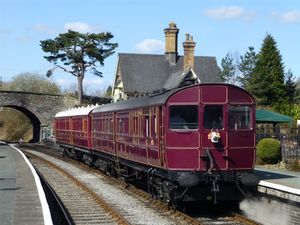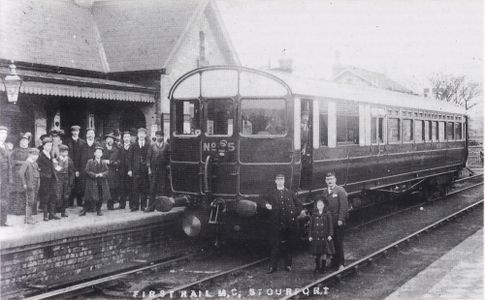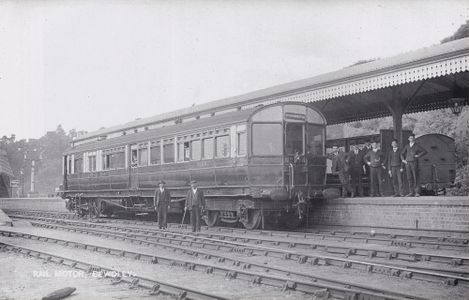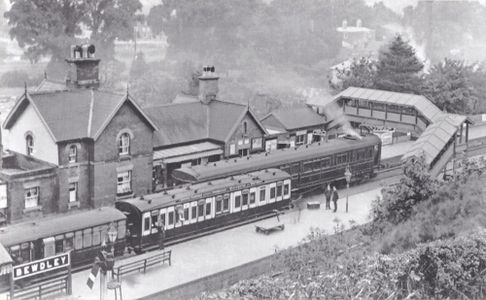GWR Steam Railmotor
The GWR steam railmotor was a self-propelled carriage powered by a vertical boiler steam engine incorporated into a bogie at one end of the carriage. It could be driven from either end, meaning that unlike a locomotive-hauled train, there was no need to 'run round' when reaching the terminus of a route. Steam railmotors saw regular use on the Severn Valley and Tenbury branches between 1905 and 1918. None survived as originally built, with most being converted into autocoaches, although No 93 (pictured) has since been restored to its original form.
Contents
GWR steam railmotors
In early 1903 the GWR carried out a trial using a borrowed steam railmotor designed by Dugald Drummond for the LBSC/LSWR. GWR Locomotive Superintendent George Jackson Churchward then designed the GWR's first steam railmotors which entered service in May 1903. The GWR would eventually build a total of 99, the largest fleet of any of the railway companies, with the last examples completed in 1908.[1] Despite the short time period and relatively low numbers, there were many variants involving more than 20 different Diagrams. Lengths varied between 57ft and 75ft, driving wheels between 3ft 5in and 4ft, and cylinder sizes between 9in×15in and 12in×16in. A full list of these is included.[2]
| Diagram(s) | Quantity | Numbers | Completed | Length |
|---|---|---|---|---|
| A, A1 | 2 | 1-2 | 1903 | 57ft |
| B, C, D | 12 | 3-14 | 1904 | 59ft 6in |
| E | 2 | 15-16 | 1905 | 56ft |
| F, G, G1 | 12 | 17-28 | 1904 | 59ft 6in |
| H, J, J1 | 8 | 29-36 | 1905 | 59ft 6in |
| K, K1 | 4 | 37-40 | 1905 | 70ft |
| L | 2 | 41-42 | 1905 | 59ft 6in |
| M, M1, N | 10 | 43-52 | 1905 | 70ft |
| O | 18 | 53-58, 61-72 | 1906 | 70ft |
| P | 2 | 59-60 | 1905 | 70ft |
| Q | 8 | 73-80 | 1906 | 70ft |
| Q1 | 3 | 81-83 | 1907 | 59ft 6in |
| R | 16 | 84-99 | 1908 | 70ft |
Nos 3 to 16 did not provide luggage space and were designated as the "suburban" type. A small luggage compartment was added from No 17 on, with Nos 1-2 and the later examples designated the "branch" type. The railmotors could be used singly or with a single trailer car.[1]
From around 1905 the GWR also began to develop auto-train services. These were mainly aimed at higher density services, with an auto-fitted steam locomotive (such as former resident GWR 1450) capable of hauling or propelling up to four carriages or autocoaches. The steam railmotors soon became a victim of their own success by generating more traffic than they were capable of handling with their single trailer and relatively low power, and from 1915 onwards they were progressively converted for use as autocoaches. This was a relatively simple process which mainly involved replacing the internal steam engine with extra seating and a guard's compartment. 85 of the 99 were ultimately converted into autocoaches in this manner, including Steam Railmotor 93, with the last steam railmotors being withdrawn from service in September 1935.[3]
No 93 was successfully restored to original condition as a working steam rail motor in 2011 by the Great Western Society at Didcot Railway Centre[4].
Steam Railmotors on the Severn Valley Railway
The introduction of electric tram services around the end of the 19th century provided competition with the railways for local passenger services. One such tramway was the Kidderminster and Stourport Electric Tramway which opened in 1879. The GWR, along with other railway companies, began to use railmotors to meet this competition.
A steam railmotor was trialled between Kidderminster, Bewdley and Stourport on 29 December 1904. A full service using two railmotors was introduced on the same section on 2 January 1905, also calling at Foley Park Halt which opened the same day.[5] The GWR produced a postcard to mark the introduction of the service; the railmotor pictured is No 35, one of eight 59ft 6in examples built to Lot 1078 and completed in 1904. Another of the eight, No 29, was also noted in the area around that time.[5]
Kidderminster Corporation had written to the GWR in October 1904 complaining about the service on the Tenbury Branch and in particular the "want of a train from Woofferton in the evenings". In March 1905 the GWR responded that "In connection with the ensuing revision of timetables for May and June next, the question of running a Rail Motor Car from Tenbury to Kidderminster at about 6pm is having consideration". The first railmotor service to Woofferton left Kidderminster on 1 May 2005 at 3.48pm, with the return departing at 5.34pm.[5][note 1]
Rifle Range Halt opened in June 1905 and was also served by the railmotors. Shortly after that time the GWR produced another picture showing railmotor No 54 at Bewdley. No 54 was a larger 70ft example built in August 1905 as part of Lot 1088. It spent at least six months on the Stourport Triangle and Woofferton services before moving to Oxford.
The picture below is dated at some time between May 1908 and February 1911 and shows another railmotor which has arrived at Bewdley's Platform 1. This is a 70ft Diagram R example, possibly No 91 built in February 1908. The train at platform 2 is a service from Woofferton to Birmingham New Street via Kidderminster; the rear-most carriage is a through LNWR coach which was attached to this service until the practice was ended in 1917.[6]
The 1910 Timetable included a separate table for the Steam Railmotor service between Kidderminster, Bewdley and Stourport, described as "Motor Cars – One class only". These provided a regular weekday service starting before 8am and finishing after 9pm. One railmotor service also ran from Worcester as far as Bridgnorth.
In January 1911 a third railmotor was introduced between Hartlebury and Bewdley.[7] Other railmotors in use around that time included Nos 66, 73, 77 and 98.
During the First World War, the Kidderminster to Woofferton steam railmotor service was ended in 1916 as a wartime economy measure. Use of railmotors on the Severn Valley branch ended in 1918[7].
See also
Notes
- ↑ After arriving at Kidderminster at 7.02pm, the railmotor ran empty to Stourbridge Junction, suggesting it may have been based at Stourbridge Shed.
References
- ↑ 1.0 1.1 Harris (1966) p. 61.
- ↑ Harris (1966) pp. 144-146.
- ↑ Harris (1966) pp. 64-65.
- ↑ Didcot Railway Centre
- ↑ 5.0 5.1 5.2 Beddoes & Smith (1995) pp. 56-57.
- ↑ Beddoes & Smith (1995) p. 79.
- ↑ 7.0 7.1 Marshall (1989) p. 143.



